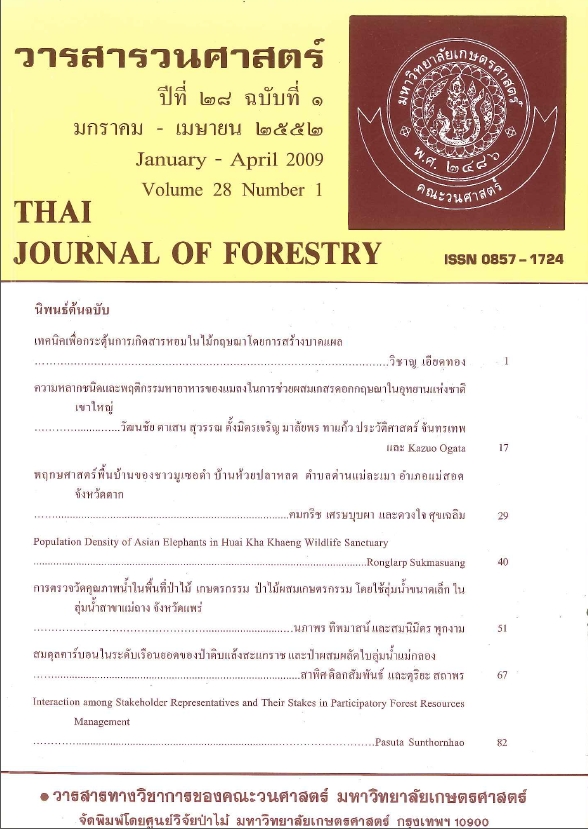เทคนิคเพื่อกระตุ้นการเกิดสารหอมในไม้กฤษณาโดยการสร้างบาดแผล
Main Article Content
บทคัดย่อ
การศึกษาเพื่อคัดเลือกเทคนิคใช้ในการกระตุ้นการสะสมสารหอมของเนื้อไม้ในต้นกฤษณาอายุประมาณ 18 ปี ซึ่งปลูกไว้ในบริเวณสถานีฝึกงานนิสิตวนศาสตร์วังน้ำเขียว อำเภอวังน้ำเขียว จังหวัดนครราชสีมา ได้คัดเลือกต้นกฤษณา 4 ต้น มีขนาดเส้นรอบวง ที่ระดับความสูงเพียงอกอยู่ระหว่าง 84.5-108.5 เซนติเมตร แล้ว ทำการเจาะลำต้นด้วยดอกสว่านขนาด 8 มิลลิเมตร กระตุ้นให้เกิดการสะสมสารหอมใช้เงื่อนไขจำนวน 17 ชุดการทดลอง วัตถุประสงค์เพื่อศึกษารูปแบบการสะสมสารหอมและฤดูกาลที่มีผลต่อการสะสมสารหอม และคุณภาพของเนื้อไม้หอมที่ได้ในแต่ละชุดการทดลอง เก็บข้อมูลทุกๆ 3 เดือนหลังการเจาะและเก็บข้อมูลต่อเนื่องติดต่อกันจนครบ 12 เดือน ผลการศึกษาพบว่าการสะสมสารหอมของต้นกฤษณามี 3 รูปแบบคือ รูปแบบที่1 เกิดเป็นวงบางๆ รอบรอยแผลและมีไม้ผุแทรกกั้นระหว่างกับรูเจาะ รูปแบบที่ 2 เกิดเป็นวงรอบรอยแผลและไม่มีเนื้อไม้ผุ และรูปแบบที่ 3 ไม่เกิดการสะสมสารหอมเลย ผลการเปรียบเทียบการสะสมสารหอมในเนื้อไม้กฤษณาระหว่างฤดูฝนกับฤดูแล้งพบว่าในฤดูแล้งเกิดในปริมาณมากกว่าและการเกิดเนื้อไม้ผุน้อยกว่า ชุดการทดลองที่กระตุ้นการสะสมสารหอมได้ดีตามลำดับมากไปหาน้อยดังนี้คือ ชุดการทดลองรูเจาะใส่สาร 0.1M methyl jasmonate, 0.01M methyl jasmonate, 5% Ethrel และ 10% Ethrel ตามลำดับ
คำสำคัญ: กฤษณา เนื้อไม้ที่มีสารหอม เทคนิคการกระตุ้นสารหอม
Downloads
Article Details

อนุญาตภายใต้เงื่อนไข Creative Commons Attribution-NonCommercial-NoDerivatives 4.0 International License.
ข้าพเจ้าและผู้เขียนร่วม (ถ้ามี) ขอรับรองว่า ต้นฉบับที่เสนอมานี้ยังไม่เคยได้รับการตีพิมพ์และไม่ได้อยู่ในระหว่างกระบวนการพิจารณาตีพิมพ์ลงในวารสารหรือสิ่งตีพิมพ์อื่นใด ข้าพเจ้าและผู้เขียนร่วม (ถ้ามี) ยอมรับหลักเกณฑ์และเงื่อนไขการพิจารณาต้นฉบับ ทั้งยินยอมให้กองบรรณาธิการมีสิทธิ์พิจารณาและตรวจแก้ต้นฉบับได้ตามที่เห็นสมควร พร้อมนี้ขอมอบลิขสิทธิ์ผลงานที่ได้รับการตีพิมพ์ให้แก่วารสารวนศาสตร์ คณะวนศาสตร์ มหาวิทยาลัยเกษตรศาสตร์ กรณีมีการฟ้องร้องเรื่องการละเมิดลิขสิทธิ์เกี่ยวกับภาพ กราฟ ข้อความส่วนใดส่วนหนึ่ง หรือ ข้อคิดเห็นที่ปรากฏในผลงาน ให้เป็นความรับผิดชอบของข้าพเจ้าและผู้เขียนร่วม (ถ้ามี) แต่เพียงฝ่ายเดียว และหากข้าพเจ้าและผู้เขียนร่วม (ถ้ามี) ประสงค์ถอนบทความในระหว่างกระบวนการพิจารณาของทางวารสาร ข้าพเจ้าและผู้เขียนร่วม (ถ้ามี) ยินดีรับผิดชอบค่าใช้จ่ายทั้งหมดที่เกิดขึ้นในกระบวนการพิจารณาบทความนั้น”


